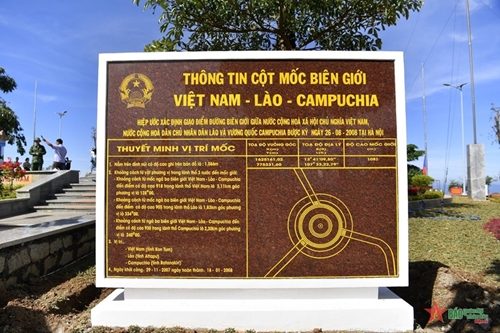The tri-border marker was jointly built by Vietnam, Laos, and Cambodia on the top of a mountain which is some 1,086m above sea level. This is the start of the Vietnam-Cambodia borderline and the end of the Vietnam-Laos borderline.
    |
 |
|
The national flags of Vietnam, Laos and Cambodia fly along the path up to the tri-border marker. |
The one-ton heavy and two-meter high tri-border marker is made of marble and has a triangular cylindrical shape. Each side of the marker faces respective country of Vietnam, Laos, and Cambodia and engraved with the national emblem, the year of the erection, and the name of each country in typical red letters of that country. The marker is in Po Y commune, Ngoc Hoi district, Vietnamese province of Kon Tum, Lao province of Attapeu, and Cambodian province of Rattanakiri.
    |
 |
|
Information about the tri-border marker |
From this windy site, we can have a panoramic view of the lands of the three neighbors of Vietnam, Laos, and Cambodia. Attentively, in just a few steps, we can go around the three countries.
Some 10km from Bo Y International Border Gate, and 3km from Indochina junction, this marker is one of the two tri-border markers in Vietnam. The other tri-border marker connects Vietnam, Laos and Cambodia and is located in A Pa Chai village, Sin Thau commune, Muong Nhe district, Vietnamese province of Dien Bien.
    |
 |
|
Each side of the three-sided marker has the name and national emblem of Vietnam, Laos, and Cambodia. |
Constructed on November 29, 2007 and inaugurated on January 18, 2008, the tri-border marker of Vietnam, Laos, and Cambodia is a testament to the peace and friendship of the three Indochinese countries, a symbol of the will, aspirations and determination to cooperate to address territorial boundary issues of the governments and peoples of the three countries. It also demonstrates trust, understanding and spirit of friendly cooperation among Vietnam, Laos, and Cambodia.
Currently, the tri-border marker is a tourist attraction for both domestic and international tourists. The Kon Tum provincial People’s Committee approved a project with the goal of making advantage of this marker to develop local tourism, importantly contributing to local hunger eradication and poverty reduction, and maintenance of border security and defense, social order and safety.
    |
 |
|
The Indochina junction borders Vietnam, Laos, and Cambodia and has become a tourist attraction. |
With its special significance, the marker has been an address for education about the close-knit ties among Vietnam, Laos and Cambodia, “returning-to-the-roots” programs, people-to-people and border external affairs activities, boosting the friendship and friendly cooperation among specialized forces of the Vietnamese province of Kon Tum, the Lao province of Attapeu, and the Cambodian province of Rattanakiri.
The organization of the first Vietnam-Laos-Cambodia border defense friendship exchange at the tri-border marker is expected to further embellish and emphasize the eternal truth that the tri-border marker is a junction of trust, will, and goal of upholding solidarity among Vietnam, Laos, and Cambodia at any costs.
    |
 |
|
The welcome gate to the tri-border marker |
Many meaningful and symbolic activities within the exchange will be held at this marker. They include saluting and painting the sovereignty marker, joint patrol among the border protection forces of the three countries, planting friendship trees, conveying a message of solidarity and friendship, contributing to building the Vietnam-Laos-Cambodia borderline of peace, friendship, stability, cooperation and development.
Translated by Mai Huong